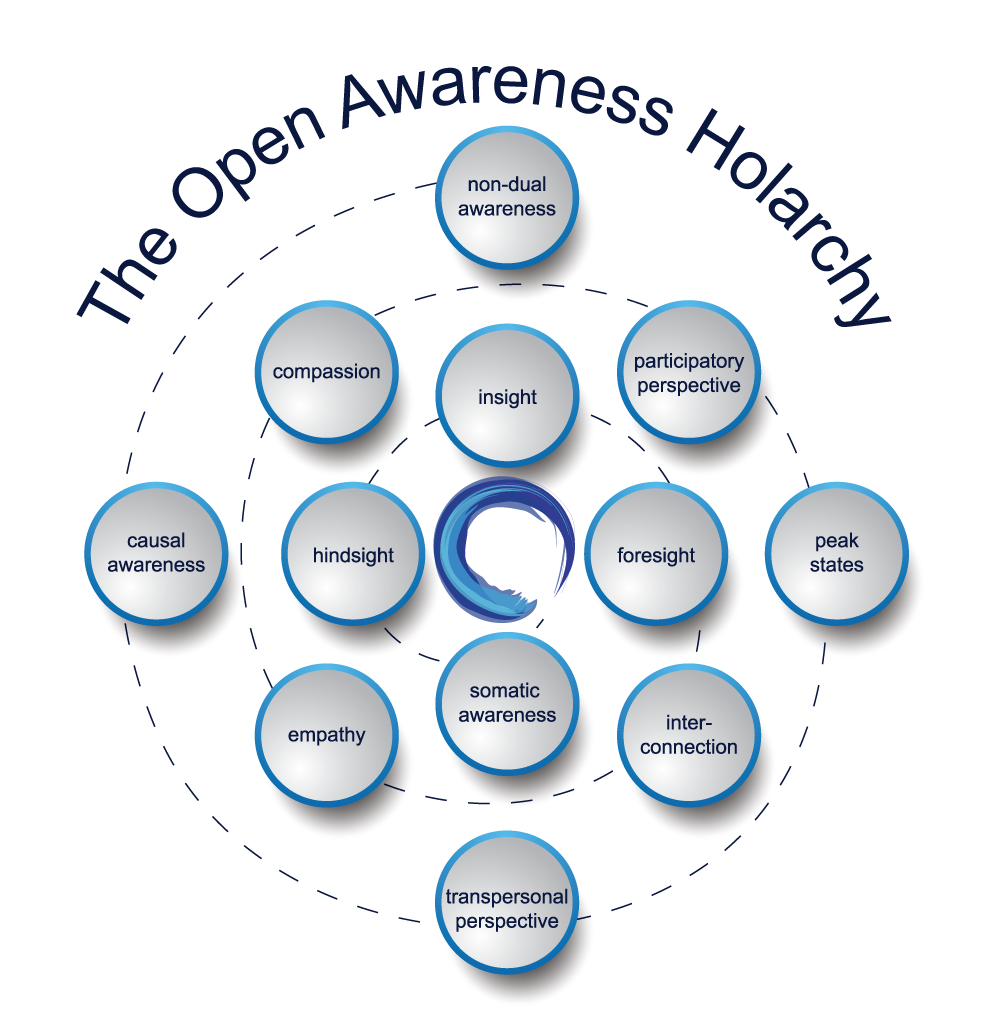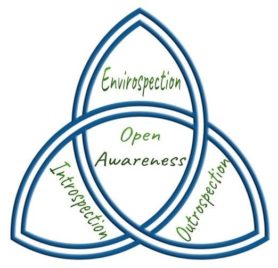Open Awareness (OA) is a flowing moment of pure experience interconnected with the rest of reality – a Holarchy!
In the introduction to OA, I covered how this mindful mode of perception can help to reduce stress and rescue ‘digital zombies’.
In this article I will introduce the OA Holarchy — a holistic system of interrelated states, perspectives and dimensions — that includes a theory of how the body, mind and spirit are connected.

A holarchy is a system composed of interrelated and interacting holons
A holon is something that is simultaneously a whole and a part of a larger whole (Koestler, A. 1967). Holons are influenced by and influence larger wholes. Similarly, since a holon is comprised of parts, it is also influenced by and influences these parts. When energy or information flow between holons within a system is compromised, for any reason, the system begins to break down. For example, wholes might not recognize their dependence on the individual parts that they are comprised of, or parts might not recognize the larger holarchy in which they co-exist (Ibid). Cancer may be understood as such a breakdown within the body. Conflicts can arise because of such breakdowns in communication. Crises ensue when such breakdowns occur in one’s psyche.
Open awareness (OA) techniques promote the embodied actualisation of oneself (and of everyone) as interconnected holons within larger holarchies. To put it simply, we are all part of larger (collective and transpersonal) realities. These larger realities exist because each of us exists. An individual’s personal reality is influenced by the state of the collective and transpersonal realities. Similarly, each individual’s present state influences the overall state of the collective and transpersonal realities. Very simply, OA makes one more aware of their wholeness.
The three core dimensions (holons) of the OA Holarchy include:
- Personal (embodied)
Typical states and perspectives: somatic awareness, hindsight, insight, foresight - Interpersonal (relational)
Typical states and perspectives: interconnection, empathy, compassion, participatory perspective - Transpersonal (spiritual)
Typical states and perspectives: peak states, transpersonal perspective, causal awareness, non-dual awareness
Characteristics of the OA experience
The following paragraphs briefly describe the typical states and/or perspectives (each one being a holon) that have been found to be associated with open awareness, as depicted in the OA Holarchy image above.
Somatic awareness
When beginning to practice OA, you may start by focusing your attention within the body, e.g., the feeling of the breath flowing into and out of the abdominal area. Through keeping the feeling of the breath in awareness, but simultaneously expanding your field of awareness to include the entire body, somatic awareness (awareness of sensations, emotional feelings and the overall state of the body) becomes enhanced.
Hindsight
With somatic awareness in a heightened state, you can more easily track specific sensations in the body or emotional feelings back to their ‘roots’. One can also elicit from the sensations, emotional feelings, or one’s overall state, what is required by the body in terms of health and healing outcomes.
Insight
OA quietens the inner ‘chatter box’ or ‘monkey mind’ and induces a state of calm mindfulness. From this state insights often arise, especially when one is seeking a solution to a problem, or wanting to increase the probability of gaining creative inspiration.
Foresight
With a quiet and present (and timeless) state of mind, sometimes realisations come into conscious awareness that pertain to potential experiences in your near or distant future. Such foresights can serve as warnings and provide motivation to take certain actions. OA also equips you to more effectively visualise the outcomes that you would like to bring about in your future, thereby enhancing the possibility of achieving those outcomes.
Interconnection
OA promotes an expanded sense of self, in which you can experience a deep sense of everyone and everything being interconnected. Quantum physics and most major spiritual systems support this possibility. The universe can be viewed as a dynamic holarchy of interrelated holons, of which you are one. None of the properties of the holarchy are fundamental. They all follow from properties of the other holons and the overall consistency of their interrelations determines the structure of the entire holarchy.
Empathy
With a deep sense of everyone and everything being interconnected, empathy toward others flows naturally and effortlessly. You find yourself relating to people meaningfully, identifying their needs and values, as well as being able to truly hear and accept them without preconceived judgement.
Compassion
As your sense of connection with yourself and between you and others continues to deepen, compassion arises. For example, you may identify and feel how somebody is suffering, and you typically find yourself approaching them with more care and kindness.
Participatory perspective
Emerging from a deep realisation of your connection with everyone and everything, comes the participatory perspective. This view reveals the cocreative quality of all events – from material to abstract and from personal to transpersonal.
Transpersonal Psychologist, Dr. Jorge Ferrer is well respected for his Participatory Vision of Spirituality. In his 2011 article, Ferrer writes: “…the participatory approach holds that human spirituality emerges from our cocreative participation in a dynamic and undetermined mystery or generative power of life, the cosmos, and/or the spirit” (p 2). He suggests that spiritual cocreation has three interrelated dimensions—intrapersonal, interpersonal, and transpersonal. These dimensions respectively establish participatory spirituality as “embodied (spirit within), relational (spirit in-between), and enactive (spirit beyond)” (p 3). Ferrer’s theory provides a significant rationale for the OA holarchy model.
Peak states
Feelings of aliveness, joy, bliss and flow describe the peak states of consciousness that can spontaneously arise from an unconditional open awareness. You feel aligned within yourself and simultaneously connected to a vast and exquisite reality. Everything has meaning and value in such states. They are profoundly inspiring and can be transformative.
Transpersonal perspective
Transpersonal can be defined as “experiences in which the sense of identity or self extends beyond (trans) the individual or personal to encompass wider aspects of humankind, life, psyche or cosmos” (Walsh & Vaughn, 1993). It has also been described as “development beyond conventional, personal or individual levels” (Scotton, 1996). OA promotes a transpersonal perspective through expanding your sense of self beyond ego, integrating a more transcendent and holistic identity.
Causal Awareness
A transpersonal perspective involves becoming more aware of the causes of your present life circumstances: personality traits, behaviours, health, relationships (including how you relate to money), occupation, as well as your level of fulfilment, happiness, wellbeing, etc. The transpersonal realm can be thought of as the world of causes, and the material realm (your physical life) is the world of effects. Thoughts and emotions precede manifestation in the material realm, but what causes us to think and feel the way we do? With causal awareness you become more capable of tapping into the preconscious realm. This enables you to not only become more aware of what causes you to think, feel and behave the way you do, but also equips you to be a more conscious co-creator of your life circumstances.
Non-dual awareness
Non-dual means “not two”. This primordial state can be thought of as a highly developed state of consciousness, in which the dichotomy of I-other (subject-object) is transcended. In non-dual awareness the ego dissolves temporarily and the experience has been described as “pure openness”, “pure consciousness” and “pure being” (Fenner, 2011). Glimpses of non-dual awareness can spontaneously occur through being in open awareness, however, it is more commonly the result of prolonged meditation and contemplative practice. None the less, OA itself can serve as a simple yet effective meditation and contemplative practice (E.G., Dängeli, 2020 and Whenary, 2012).
A theory for how the body, mind and spirit are connected
The three dimensions of the OA Holarchy are each holons with subsidiary holons (expressed in terms of states and perspectives – as outlined above). These are all connected along a metaphorical spiraling continuum, rather than separate levels (as you can see in the diagram above). The spiral depicts the flow of immanent consciousness (bottom-up) and transcendent consciousness (top-down) as simultaneous throughout the holarchy. Seen through a cartesian lens, transcendent consciousness flows downward or inward from transpersonal to personal. Likewise, immanent consciousness flows upward or outward from personal to transpersonal. Looked at from a participatory perspective, both transcendent and immanent consciousness can stem from various co-arising sources along the spiraling continuum. As open awareness develops, eventually the concepts of inner and outer, as well as upper and lower lose significance. Ultimately, according to this model, we are all unique and autonomous expressions of the ‘Whole’. While undefinable in common language, the Whole might be described as both the source and the subject of everything in existence.
What does this mean to you?
Through practicing OA, one’s consciousness becomes both ‘embodied’ and ‘expanded’ at the same time. This has potential healing, transformative and heuristic value; being the kinds of outcomes that my clients and course participants have reported since 2004, and which was evident in the research results documented in Dängeli, 2020.
In a nutshell, OA could be described as the process of bringing awareness into the ‘space’ in between yourself and that which you are experiencing in the moment (person, object, sensory perception, thought or feeling). As OA deepens, your experience of this space expands, the subject/object divide dissolves, and you become more aware of the subtler realms, including preconscious content.
Through practicing OA you learn to become comfortable with the unknown. You discover how to tap into the realm beyond your conscious awareness to lead a more productive and fulfilling life, or, perhaps most fundamentally, as Ferrer (2011) puts it: “participate more fully in the mystery out of which everything arises” (22).
OA specific training (online and live courses)
OA is a fundamental approach taught in the Authentic Self Empowerment Facilitator Training and it is a central aspect of the Transpersonal Coach Model.
References:
Dängeli, J. (2020). Exploring the phenomenon of open awareness and its effects on stress and burnout. Consciousness, Spirituality & Transpersonal Psychology, 1, 76-91. https://www.journal.aleftrust.org/index.php/cstp/article/view/9
Fenner, P. (2011). Revealing Nondual Awareness. http://www.radiantmind.net/revealing-nondual-awareness-peter-fenner/
Ferrer, J. (2011). Participatory Spirituality and Transpersonal Theory: A Ten-Year Retrospective. The Journal of Transpersonal Psychology, 2011, Vol. 43, No. 1
Koestler, A. (1967). The Ghost in the Machine (1990 reprint ed.). London: Hutchinson (Penguin Group).
Scotton, B. W. (1996). Introduction and Definition of Transpersonal Psychiatry. In Scotton, B.W., Chinen, Allan B. and Battista, John R., Eds.Textbook of Transpersonal Psychiatry and Psychology. New York: Basic Books
Walsh, R & Vaughan, F. (1980). Journal of Humanistic Psychology 20.
Whenary, R. (2012). Living in Open Awareness. http://www.livinginopenawareness.com/LIOA(BasicV).pdf
